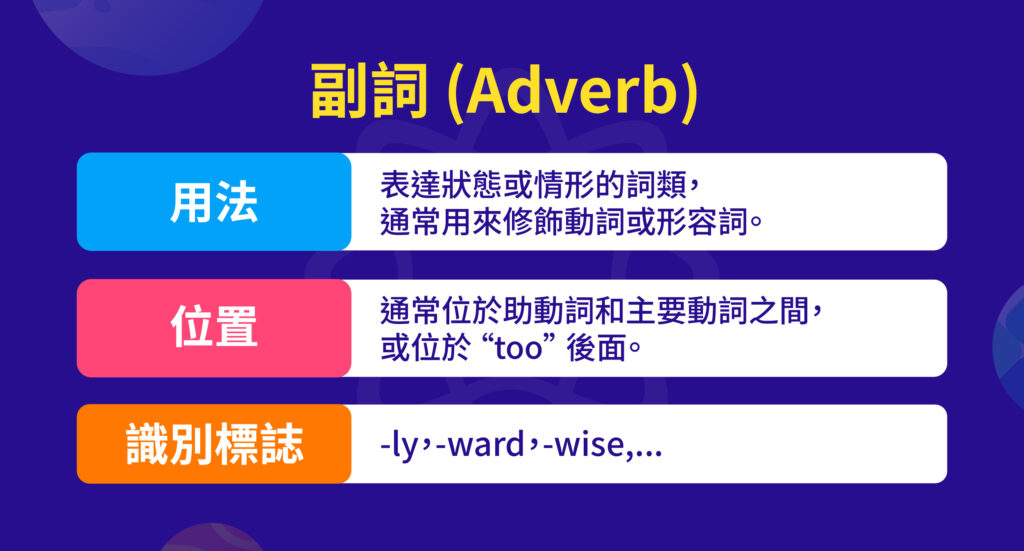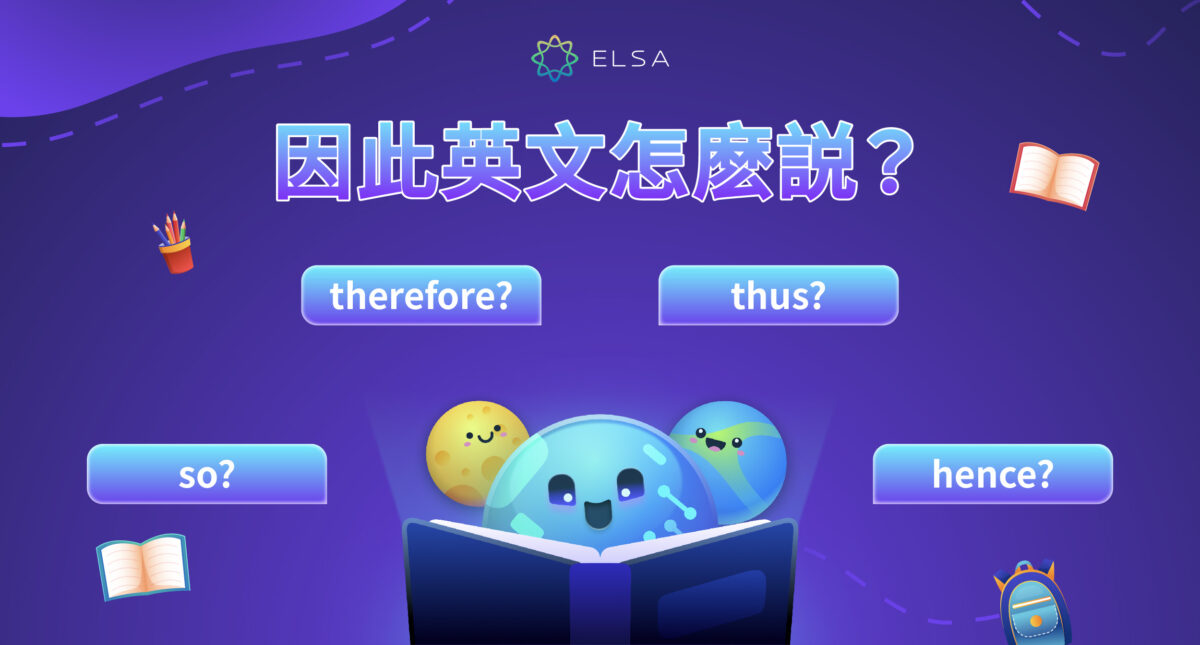每個詞性在句子中都有其角色和功能,這些詞性共同構成句子的結構,以表達完整的意思。詞性英文中有 八大種常見的,讓我們一起跟隨 ELSA Speak 明確區分英文中的各種詞性以及它們的用法和位置吧!
英文詞性是什麼?

英文詞性是指一組具有相同特徵的詞,這些詞可以通過詞的結構來識別。每個詞性在句子中有不同的功能和位置。
以下是 8 種主要的詞性英文:
- 名詞 (Noun)
- 動詞 (Verb)
- 形容詞 (Adjective)
- 副詞 (Adverb)
- 介詞 (Preposition)
- 連詞 (Conjunction)
- 感嘆詞 (Interjection)
- 代詞 (Pronoun)
以下是各種英文詞性用法和例子:
| 詞性 | 功能 | 例子 | 英文詞性位置 |
| 名詞 (Noun) | 表示人、物、事件 | Fang,Sheng, cat, pen, book,… | Sheng is discussing with Fang about their upcoming project. |
| 動詞 (Verb) | 表示動作、狀態 | speak, eat, sleep, go, sing, dance,… | John speaks fluent Spanish. |
| 形容詞 (Adjective) | 描述名詞、動詞 | good, big, black, full, interesting,.. | The beautiful flowers bloomed in the garden. |
| 副詞 (Adverb) | 修飾動詞, 形容詞或副詞的意思 | slowly, well, very, really, quickly,… | He runs really slowly. |
| 介詞 (Preposition) | 連接名詞 | to, at, in, on, for, by | The book is on the table. |
| 連詞 (Conjunction) | 連接詞語、子句、句子、段落… | and, or, also, that, since,… | Sarah loves to read books, and she also enjoys watching movies. |
| 感嘆詞 (Interjection) | 表示感嘆的詞 | OMG!, yeah!, yay,… | Yay! We won the game! |
| 代詞 (Pronoun) | 替代名詞 | I, you, we, he, she, it, they | Catherine is going to the store. She needs to buy some groceries |
注意: 可以通過單詞的詞尾來英語文詞性判斷法,例如:
- 名詞 (Noun): 詞尾 –tion: creation, education.
- 動詞 (Verb): 詞尾 –ate: create, communicate.
- 形容詞 (Adjective): 詞尾 –able / -ible: comfortable, possible.
>>閲讀更多:
英文八大詞性
名詞 (Noun)

名詞(Noun)是用來指人、事物、地點或某種現象的詞。例如:: house, cat, flower, book,…
名詞的位置
- 位於形容詞/物主形容詞之後 (his, her, their, your, my, its).
例子: This is my pen.
大致翻譯: 這是我的筆。
- 位於動詞之後,作為賓語 (object).
例子: It’s not my fault.
大致翻譯: 這不是我的錯。
- 位於冠詞 “the, a, an” 或指示代詞 “this, that, these, those” 之後
例子: I like reading a book.
大致翻譯: 我喜歡看一本書。
- 位於表示地點的介詞 (in, on, at, under,…) 之後。
例子: I found my ruler under the table.
大致翻譯: 我在桌子下找到了一把尺子。
- 位於 a few, any, some, every, enough, little, a little, all, each,… 之後。
例子: Did you bring any bread? (你有拿著哪條麵包嗎?)
名詞的識別標誌
以下是通過後綴來識別名詞的幾種方法:
| 後綴 | 例子 | 翻譯 |
| -tion | Function, Notion | 功能, 概念 |
| -ess | Sadness, Kindness, Flatness | 悲傷, 善良, 平坦 |
| -ment | Moment, Contentment | 時刻, 滿足 |
| -sion | Confusion, Division, Television | 猶豫, 劃分, 電視 |
| -ce | Performance, Convenience | 表演, 便利 |
| -ity | Identity, Responsibility, Opportunity | 識別、責任、機會 |
| -er / -or | Error, Terror, Instructor | 錯誤、恐懼、導師 |
| -ship | Friendship, Citizenship, Championship | 友誼、公民權、榮耀 |
| -ism | Heroism, Minimalism, Racism | 英雄主義、極簡主義、種族主義 |
| -ture | Temperature, Agriculture, Culture | 溫度、農業、文化 |
| -phy | Autography, Photography | 手寫簽名、攝影 |
| -logy | Biology, Technology | 生物學、技術 |
| -hood | Childhood, Manhood, Likelihood | 童年、成年、能力 |
| -an / -ian | Musician, Vegetarian | 音樂家、素食者 |
| -itude | Attitude, Solitude | 態度、分離 |
| -ic | Magic, Economic | 魔法、經濟 |
| -age | Cabbage, Advantage, Disadvantage | 捲心菜、優勢、劣勢 |
| -th | Length, Strength, Youth | 長度、力量、青春 |
動詞 (Verb)

動詞(Verb)在英語中用來描述主體的動作、情感或狀態。例如: ask (詢問), suggest (建議), discuss (討論),…
動詞的位置
- 位於主語之後。
例子: I love to eat chicken.
大致翻譯: 我喜歡吃雞肉。
- 位於表示時間、頻率的副詞之後。 (always, sometime, usually, often,… ).
例子: I usually travel every month.
大致翻譯: 我通常每個月旅行一次。
識別標誌
英語中的動詞通常帶有以下後綴:
| 後綴 | 例子 | 翻譯 |
| -ize | Minimize, Criticize, Realize | 縮小, 評估, 意識到 |
| -en | Strengthen, Lengthen, Threaten | 加強, 延長, 威脅 |
| -ate | Create, Debate, Donate | 創造, 爭論, 捐贈 |
| -ify | Notify, Simplify, Classify | 通知, 簡化, 分類 |
形容詞 (Adjective)

形容詞(Adjective)是英文中的詞性,用來表達事物、事件或現象的特徵。
形容詞的位置
- 位於名詞之前,修飾名詞。
例子: I bought a new t-shirt.
大致翻譯: 我買了一件新T恤。
- 位於動詞 “to be” 之後。
例子: I am not good at English.
大致翻譯: 我的英語不好。
- 位於副詞之後。
例子: This donut is insanely tasty.
大致翻譯: 這個甜甜圈非常好吃。
- 位於 “too”, “so”, “very”之後。
例子: She is very smart.
大致翻譯: 她非常聰明。
- 位於情態動詞後,例如 seem, feel, taste, look,…
例子: You seem sad. What’s the problem?
大致翻譯: 你看起來不開心。有什麼問題嗎?
形容詞的識別標誌
| 後綴 | 例子 | 翻譯 |
| -ful | Joyful, Peaceful, Colorful | 快樂、平靜、五彩繽紛 |
| -ed | Wicked, Tired, Worried | 殘酷、疲倦、焦慮 |
| -al | Herbal, Frugal, Special | 草本、清淡、特別 |
| -less | Friendless, Useless, Homeless | 沒有朋友、無用、無家可歸 |
| -able | Dependable, Capable, Available | 可靠、有能力、可用 |
| -ive | Creative, Attractive, Active | 有創意、有吸引力、活躍 |
| -ic | Chaotic, Fantastic, Energetic | 混亂、很棒、充滿能量 |
| -ish | Selfish, Lavish, Foolish | 自私、奢華、愚蠢 |
| -y | Angry, Windy, Messy | 生氣、多風、凌亂 |
副詞 (Adverb)

副詞是詞性英文,用來描述狀態或情況,修飾動詞或形容詞。
例如: quickly (快速地), well (好地), interestingly (有趣地),…
副詞的位置
- 表示頻率的副詞: often, always, usually, seldom,… 位於 tobe 之後且在普通動詞之前。
例子: I often get up late on weekends.
大致翻譯: 我週末經常起晚。
- 位於助動詞與普通動詞之間。
例子: The children have recently finished their homework.
大致翻譯: 孩子們剛完成了作業。
- 位於動詞 to be / seem / look / feel / appear / sound… 之後,形容詞之前。
例子: They seem very excited when listening to music.
大致翻譯: 他們聽音樂時顯得非常興奮。
- 位於 “too” 之後。
例子: The man speaks too quickly.
大致翻譯: 那個男人說話太快了。
- 位於 “enough” 之前。
例子: He ran quickly enough to catch the train.
大致翻譯: 他跑得很快,趕上了火車。
- 副詞在 so…that 結構中使用。
例子: The girl is so beautiful that everyone likes her.
大致翻譯: 那個女孩太漂亮了,人人都喜歡她。
副詞的識別標誌
| 後綴 | 例子 | 翻譯 |
| -ly | Beautifully, Carefully, Badly | 美麗地、小心地、糟糕地 |
| -ward | Downwards, Homeward, Upwards | 向下、向家、向上 |
| -wise | Sideways, Clockwise, Lengthwise | 縱向, 順時針, 橫向 |
介詞 (Preposition)

介詞是英文中的詞性,用來表示句中提到的事物、事件之間的時間、情境或位置關係。
介詞的位置
- 位於形容詞之後。
例子: She is fond of traveling.
大致翻譯: 她喜歡去旅行。
- 位於普通動詞之後。
例子: David is standing between Lisa and Jack.
大致翻譯: 大衛站在麗莎和傑克之間。
- 位於動詞 “tobe” 和名詞之間。
例子: The dog is under the desk.
大致翻譯: 狗在桌子底下。
介詞的分類
- 時間介詞
| 時間介詞 | 翻譯 |
| On | 在某天(通常與日期連用) |
| At | 在某時刻(通常與具體時間連用) |
| Before | 在……之前 |
| After | 在……之後 |
| During | 在……期間 |
| In | 在(與月份、年份、世紀連用) |
| Through | 直到(某一時間點) |
例子: We often go skiing in the winter.
大致翻譯: 我們通常在冬天滑雪。
- 目的介詞
| 目的介詞 | 翻譯 |
| So as to / In order to / To | 為了 |
| For | 為了 |
| Thanks to | 由於 |
例子: I am going to France for a few days.
大致翻譯: 我會去法國幾天。
- 體格介詞
| 體格介詞 | 翻譯 |
| With | 用……;帶著…… |
| Without | 沒有 |
| According to | 根據 |
| In spite of | 儘管 |
| Instead of | 代替 |
例子: A coat with two pockets.
大致翻譯: 這件外套有兩個口袋。
連詞 (Conjunction)

連詞是英語中用來連接詞、短語或子句,組成完整句子的詞性。
例子: Lisa was disappointed because he did not win the first prize.
大致翻譯: Lisa 因為沒有拿到第一名而感到失望。
連詞的分類
- 連接連詞
| 連接連詞 | 功能 | 例子 |
| And (和), so (所以), yet (但是), but (但是), for (为, 因为), as (因为, 由于) | 用來連接兩個或多個詞、短語或句子。 | I like my current job, and I enjoy my life as well. 大致翻譯: 我喜歡我的工作,也喜歡現在的生活。 |
- 關聯連接詞
| 關聯連接詞 | 功能 | 例如 |
| As long as (只要), although (雖然), before (之前), after (之後) | 用來連接句中的從屬子句與主要子句。 | Although Lisa was sick, she still had to take the exam. 大致翻譯: 雖然 Lisa 生病了,但她還是必須參加考試。 |
- 成對連接詞
| 成對連接詞 | 功能 | 例如 |
| Not only … but also … (不僅 … 而且 …), either … or … (要麼 … 要麼 …), neither … nor … (既不 … 也不 …) | 成對出現,用來連接兩個句子或短語。 | Either Lan or Thu likes this dish. 大致翻譯: 蘭和秋都喜歡這道菜。 |
感嘆詞 (Interjection)

感嘆詞是用來表達說話者情感的詞性。
識別標誌
- 句尾常帶有感嘆號。
- 常見的感嘆詞: Oh dear, oh my god, ouch, well,…
例子: Oh my God! The weather today is nice!
大致翻譯: 哦天啊!今天的天氣真好!
代詞 (Pronoun)

代詞是用來指代人或事物的詞性,用來替代句中已經確定的名詞或名詞短語,避免重複使用名詞,讓句子更加自然流暢。
代詞分類
- 人稱代詞
| 人稱代詞 | 用法 | 例如 |
| I, You, We, They, He, She, It | 用來指代具體的人、群體或事物。 | She will go to work during the week next. 大致翻譯: 她下週會去上班。 |
- 所有格代詞
| 所有格代詞 | 用法 | 例如 |
| Mine, yours, ours, their, his, hers, its | 用來表示某物屬於某人。 | All these books are hers.大致翻譯: 所有這些書都是她的。 |
- 反身代詞
| 反身代詞 | 用法 | 例如 |
| Myself, yourself, themself, itself, herself, himself | 用於主語和賓語是同一個對象時。 | I bought myself a watch for my birthday. 大致翻譯: 我給自己買了一隻手錶作為生日禮物。 |
- 不定代詞
| 不定代詞 | 用法 | 例如 |
| Any, many, each, every, all, both, neither,… | 表示一個或多個不確定的對象(人/物)。 | Everybody loves coffee.大致翻譯: 每個人都喜歡咖啡。 |
- 指示代詞
| 指示代詞 | 用法 | 例如 |
| This, these, that, those | 用來指示物品或識別某人。 | I love these sandals.大致翻譯: 我喜歡這雙拖鞋。 |
- 關係代詞
| 關係代詞 | 用法 | 例如 |
| Who – whom, which, that, whose | 用來連接有關聯的子句。 | The girl who is behind the column is my sister. 大致翻譯: 站在柱子後面的女孩是我的妹妹。 |
英文詞性變化表

名詞的構成規則
- 在動詞後加上後綴
| 結構 | 例子 | 結果 |
| V + -tion / -ation | introduce invent admire | introduction invention admiration |
| V + -ment | achieve employ disappoint | achievement employment disappointment |
| V + -er / -or | contract drive teach | contractor driver teacher |
| V + -ar / -ant / -ee | assist lie employ | assistant liar employee |
| V + -ence / -ance | reside exist refer | residence existence reference |
| V + -ing | run stand sing | running standing singing |
| V + -age | pack use shrink | package usage shrinkage |
- 在形容詞後加上後綴
| 結構 | 例子 | 結果 |
| Adjective + -ity | possible real national reasonable | possibility reality nationality reasonability |
| Adjective + -ism | social surreal professional fundamental | socialism surrealism professionalism fundamentalism |
| Adjective + -ness | happy sad cool willing | happiness sadness coolness willingness |
形容詞的構成規則
- 從名詞構成單一形容詞
| 結構 | 例子 | 結果 |
| Noun + -y | cloud wind sun | cloudy windy sunny |
| Noun + -ly | main man friend | mainly manly friendly |
| Noun + -ful | pity beauty harm | pitiful beautiful harmful |
| Noun + -less | care harm rest | careless harmless restless |
| Noun + -en | gold wool wood | golden woolen wooden |
| Noun + -ish | girl style child | girlish stylish childish |
| Noun + -ous | humour danger scandal | humorous dangerous scandalous |
- 從名詞構成複合形容詞
| 結構 | 例子 |
| Noun + adjective | shoe-laces |
| Noun + participle | eye-opening |
| Noun + noun-ed | three-day trip |
副詞的構成規則
| 結構 | 例子 | 結果 |
| Adjective + -ly | quick possible happy beautiful smooth | quickly possibly happily beautifully smoothly |
一些例外情況
| 詞彙 | 解釋 | 例子 |
| Friendly | 是形容詞 | She welcomes me in a friendly (adj) way. |
| Late | 同時作為副詞和形容詞 | He was late. (adj)He came late. (adv) |
| Hard | 同時作為副詞和形容詞 | The exercise is pretty hard. (adj)She works hard.(adv) |
| Early | 同時作為副詞和形容詞 | She likes being a little early for meetings. (adj)I don’t like getting up early. (adv) |
| Well | 同時作為副詞和形容詞 | He has been very well lately. (adj)I hope she is doing well. (adv) |
| Fast | 同時作為副詞和形容詞 | That car runs so fast. (adj)You’ll have to act fast. (adv) |
| High | 同時作為副詞和形容詞 | She got very high (adj) marks in her mathematics exam.He jumped high (adv) to catch the ball. |
使用英文詞性時的注意事項
英文詞性是學習英語的重要知識之一,能幫助你更有效地交流和寫作。以下是使用英文詞性時的一些注意事項:
- 明確區分英文的九種詞性:定義、位置、分類及其使用例子。
- 充分理解每種詞性的用法:每種詞性在英語中都有其獨特的用法。
例子:
– 名詞用來表示事物、現象、概念的名稱,…
– 動詞用來表達動作、狀態,…
- 熟悉英語詞性變化表:包括名詞、形容詞、副詞和一些特殊情況。
帶答案的英文詞性練習題

練習 1: 識別括號中詞語的詞性
1. She (runs) every morning. – 詞性: ________________
2. The (blue) sky looks beautiful. – 詞性: ________________
3. They enjoy (playing) football. – 詞性: ________________
4. He is (very) tall. – 詞性: ________________
5. The cat is sleeping (peacefully). – 詞性: ________________
答案
1. She (runs) every morning. – 詞性: 動詞
2. The (blue) sky looks beautiful. – 詞性: 形容詞
3. They enjoy (playing) football. – 詞性: 動詞
4. He is (very) tall. – 詞性: 副詞
5. The cat is sleeping (peacefully). – 詞性: 副詞
練習 2: 將給定的詞語排列成完整句子
1. classes / start / When / usually / your / ?
2. birthday / her / be / When / celebrated / will / ?
3. from / New York / How / to / get / Miami / can / I / ?
4. to / way / the / What / city / center / is / the / ?
5. do / weekends / What / on / you / usually / ?
6. go / summer / you / Where / did / last / ?
7. are / going / vacation / for / Where / you / ?
8. have / your / lunch / When / do / you / ?
9. to / school / do / How / you / go / usually / ?
10. movies / like / What / of / kind / you / ?
答案
1. When do your classes usually start?
2. When will her birthday be celebrated?
3. How can I get from New York to Miami?
4. What is the way to the city center?
5. What do you usually do on weekends?
6. Where did you go last summer?
7. Where are you going for vacation?
8. When do you have your lunch?
9. How do you usually go to school?
10. What kind of movies do you like?
常見問題
英文詞性 英文是什麼?
英文詞性 的英文是 parts of speech
英文詞性的縮寫
- Noun (名詞): n.
- Verb (動詞): v.
- Adjective (形容詞): adj.
- Adverb (副詞): adv.
- Preposition (介詞): prep.
- Conjunction (連詞): conj.
- Interjection (感嘆詞): interj.
- Pronoun (代詞): pron.
以上是有關英文詞性的全部知識,希望通過這篇文章能夠幫助你更好地理解詞性英文大詞性,如何有效學習英文請繼續關注 ELSA Speak 的後續文章在英語文法專欄!


 2024年/11月/28日 | Nhu Huynh
2024年/11月/28日 | Nhu Huynh








